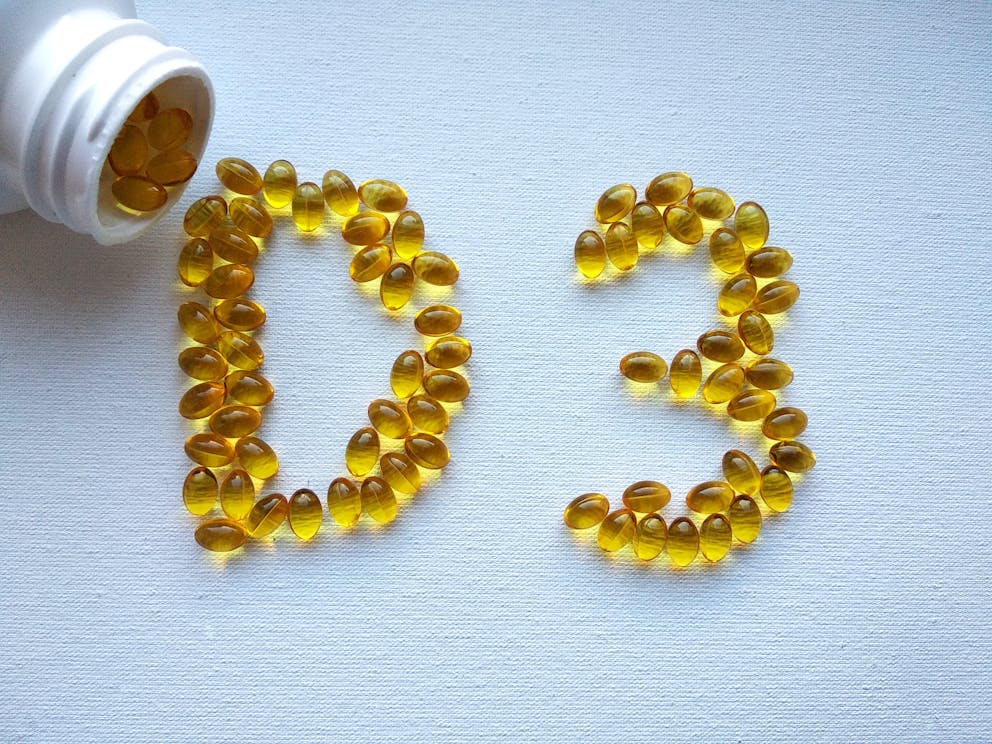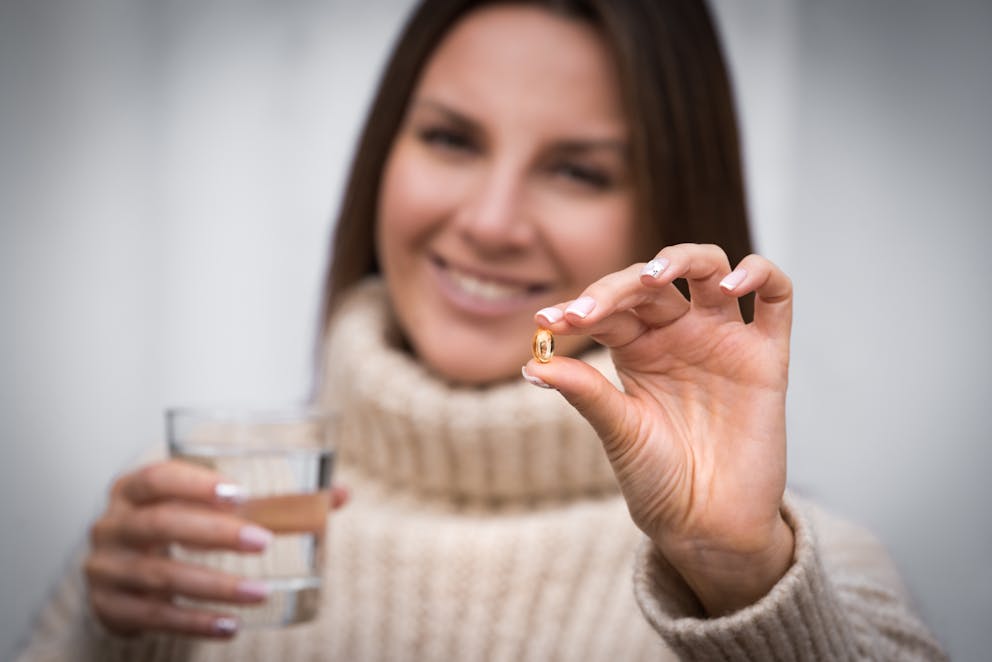Vitamin D3 – 5000 IU: Benefits of High-Dose D3 Supplementation
While vitamin D supplements are among the most popular dietary supplements, many people don’t take high enough vitamin D3 doses to prevent deficiency and maintain healthy levels.
Discover the health benefits of taking 5,000 IU of vitamin D3 daily and find out why you should always combine vitamin D3 with vitamin K2.

What is vitamin D3?
Vitamin D3, also known as the sunshine vitamin, is produced when the skin is exposed to ultraviolet B (UVB) rays in sunlight.
UVB light exposure triggers a chain of complex biochemical reactions that convert previtamin D into active vitamin D3.
“The body stores vitamin D3 in the liver and fat cells, which serve as a reservoir that the body can draw upon to compensate for short periods without sunlight exposure,” explains Dr. Berg. “However, prolonged lack of UVB radiation can deplete body stores and result in vitamin D insufficiency.”
The rate of vitamin D3 production can vary significantly from person to person and depends on many factors.
Older people and individuals with darker skin pigmentation may not generate adequate amounts of vitamin D3 despite plenty of sun exposure, which explains why older adults and those with darker skin tones are at risk of vitamin D deficiency.
Very few foods naturally contain vitamin D3, and dietary sources, including fatty fish, cod liver oil, egg yolks, beef liver, and fortified dairy products, typically don’t offer enough vitamin D3 to maintain a healthy vitamin D status.
Watch the video below to learn how much vitamin D you may need to maintain a healthy body.
How Much Vitamin D Do I Need?
Signs of vitamin D deficiency
Vitamin D regulates various physiological processes, which explains why a lack of adequate vitamin D3 can result in a wide range of symptoms.
Here are common signs of vitamin D deficiency:
Frequent infections
Fatigue
Muscle aches
Soft and brittle bones
Unexplained hair loss
Acne

How much vitamin D3 do you need?
It’s well established that vitamin D3 supplements are effective at raising and maintaining optimal vitamin D levels. However, current intake recommendations are conflicting.
While a factsheet published by the National Institutes of Health suggests a daily vitamin D dose of 600 IU, the American Academy of Family Physicians recommends 1,000 IU of vitamin D daily, and The Endocrine Society suggests that adults get between 1,500 and 2,000 IU of vitamin D per day.
So, how much vitamin D3 should you be taking?
“Your appropriate vitamin D3 dosage should always be guided by your blood concentrations of 25-hydroxyvitamin D, a blood marker that reflects your body’s overall vitamin D stores,” explains Dr. Berg.
Evidence published in Nutrients suggests that 25-hydroxyvitamin D concentrations of 40 ng/mL (100 nmol/L) or above indicate an optimal vitamin D status and that 600 IU of vitamin D isn’t enough to significantly raise vitamin D levels.
This aligns with research published in StatPearls that found that many adults require between 5,000 and 10,000 IU of vitamin D3 daily to correct a deficiency and maintain vitamin D levels.
If you are considering taking vitamin D to promote general health, it’s recommended to consult a healthcare provider to perform vitamin D testing, which helps determine your appropriate vitamin D3 dosage.
Alternatively, many pharmacies and health stores offer inexpensive finger-prick tests to evaluate vitamin D status.

Benefits of high-dose vitamin D3 (5,000 IU or more)
High-dose vitamin D3 supplementation of 5,000 IU or more is recommended for individuals with vitamin D deficiency and people at risk of low vitamin D absorption, such as older individuals and those with darker skin color.
In addition, people with certain health problems, including poor liver function, osteoporosis, Crohn’s disease, inflammatory bowel disease, and other autoimmune conditions, are at increased risk of vitamin D deficiency and can benefit from high doses of vitamin D3.
Taking between 5,000 and 10,0000 IU of vitamin D3 can enhance immune system functions and improve recovery time and health outcomes in various infectious diseases.
A study published in Nutrients investigated the effects of high-dose D3 supplementation in COVID patients and concluded, “The use of 5,000 IU vitamin D3 as an adjuvant therapy for COVID-19 patients with suboptimal vitamin D status is recommended.”

Risks of high-dose vitamin D3
While vitamin D3 is generally considered safe, it's a fat-soluble vitamin that can accumulate in the body, and taking too much vitamin D for long periods can have toxic effects.
Excessive amounts of vitamin D supplementation, especially when taken by an individual with optimal vitamin D levels, can lead to vitamin D toxicity, characterized by 25-hydroxyvitamin D blood levels greater than 100 ng/mL (250 nmol/L).
Common symptoms of vitamin D toxicity include:
Nausea and vomiting
Gastrointestinal issues
Unexplained weight loss
Confusion
Kidney stones
Elevated blood calcium levels
To avoid the risk of vitamin D toxicity, it’s recommended to perform regular blood tests and adjust your vitamin D3 dosage accordingly.
In addition, it’s important to note that individuals with a medical history of sarcoidosis, primary hyperparathyroidism, or certain cancers are more likely to experience vitamin D-related side effects and shouldn’t take extra vitamin D without consulting a healthcare professional.
Why take vitamin D3 with vitamin K2
Combining vitamin D3 and K2 benefits calcium balance and lowers the risk of skeletal issues and cardiovascular disease.
Because vitamin D3 stimulates intestinal calcium absorption, it can cause elevated blood calcium concentrations, linked to an increased risk of arterial calcification—a primary risk factor for heart disease.
Vitamin K2 activates proteins that bind calcium in the blood and deposit it into bone and teeth. Not only does this promote skeletal and dental health, but it also lowers the risk of soft tissue calcification.
How much vitamin K2 you should take with vitamin D3 depends on your vitamin D3 dose. The ideal ratio of vitamin D3 to K2 is 1000:10, and it’s recommended to take 10 mcg of vitamin K2 per 1000 IU of vitamin D3.

Five reasons to take vitamin D3
Vitamin D3 plays an essential role in calcium balance, immune defenses, nerve signal transmission, and neurotransmitter production.
Vitamin D is so critical for human health that many scientists suggest it should be classified as a hormone to emphasize the need to maintain optimal levels.
Here are five reasons to take vitamin D3.
1. Support cardiovascular health
Maintaining healthy vitamin D levels is associated with lower blood pressure and a reduced risk of cardiovascular disease.
It’s thought that vitamin D improves endothelial function, which promotes healthy blood vessels and lowers the risk of high blood pressure.
Vitamin D deficiency has been linked to narrowing blood vessels and vascular damage, significantly increasing the risk of atherosclerosis, heart attacks, and stroke.
2. Promote healthy bones
Vitamin D helps the body absorb calcium, an essential mineral needed for bone metabolism, and taking vitamin D3 in combination with vitamin K2 supports bone health and lowers the risk of skeletal issues.
Without adequate vitamin D levels, the body can only absorb a fraction of dietary and supplemental calcium, significantly increasing the risk of calcium deficiency linked to loss of bone mass, osteoporosis, and fractures.

3. Strengthen immune defenses
Vitamin D3 is needed to stimulate the activity of white blood cells, a group of immune cells that are the body's main defense mechanism against infections and diseases.
Vitamin D also regulates how immune cells interact with each other, which is crucial for balanced immune responses and helps prevent the development of autoimmune diseases such as rheumatoid arthritis, psoriasis, and multiple sclerosis.
4. Lower cancer risk
Evidence published in Trends in Cancer Research found that optimal vitamin D levels are associated with a lower risk of breast, colon, and prostate cancer.
Although more research is needed to confirm the role of vitamin D in cancer prevention, it’s believed that vitamin D enhances the ability of immune cells, such as Natural Killer cells, to eliminate potentially abnormal and or carcinogenic cells.
5. Support mental health
Vitamin D deficiency is linked to mood disorders such as depression, which explains why seasonal affective disorder (SAD) typically develops during winter months when adequate UVB exposure is limited.
Vitamin D stimulates the production of serotonin, a neurotransmitter that regulates moods, and imbalanced serotonin levels can lead to an increased risk of depression, anxiety, and attention deficit disorder (ADD).

Key takeaways
Vitamin D is vital for calcium absorption, skeletal and cardiovascular health, immune defenses, and mental well-being.
Evidence suggests that taking 600 IU of vitamin D isn’t enough and that it may require between 5,000 and 10,000 IU of vitamin D3 daily to correct a deficiency and to maintain healthy levels in individuals at risk of low vitamin D status.
Additional resources
FAQ
1. How much vitamin D3 do I need?
How much vitamin D3 you need depends on your vitamin D levels, age, skin tone, and health status.
Evidence suggests that many individuals require between 5,000 and 10,000 IU of vitamin D3 daily to achieve optimal 25-hydroxyvitamin D blood concentrations of 40 ng/mL (100 nmol/L) or above.
2. Can I take 5,000 IU of vitamin D3 every day?
Yes, taking 5,000 IU of vitamin D3 is generally considered safe and well-tolerated by most healthy adults.
3. What happens if I take 5,000 IU of vitamin D3 every day?
Taking 5,000 IU of vitamin D3 every day is beneficial to correct and prevent vitamin D deficiency and helps maintain optimal vitamin D levels.
High-dose vitamin D3 supplementation has been found to promote bone health, strong immune defenses, and healthy blood pressure and is linked to a reduced risk of depression, osteoporosis, and certain cancers.
4. Is 5,000 IU too high for vitamin D3?
5,000 IU of vitamin D3 is an ideal dose for individuals with vitamin D deficiency and those at risk of poor vitamin D absorption, including older adults and people with darker skin tones.
High-dose vitamin D3 supplementation may also benefit people with certain medical conditions, such as poor bone health, acne, hair loss, liver problems, and autoimmune diseases.
5. How quickly does 5,000 IU of vitamin D3 take to work?
Most people notice improved well-being within three to four weeks of consistent high-dose vitamin D3 supplementation.
However, individuals with vitamin D deficiency may experience noticeable effects within one to two weeks of taking 5,000 IU of vitamin D3.
6. What is the best time to take vitamin D3 5,000 IU?
Because vitamin D3 is fat-soluble, taking vitamin D with a meal helps improve its absorption, and most people find it convenient to take vitamin D supplements with breakfast or lunch.
There is evidence that vitamin D3 promotes healthy sleep, and taking vitamin D3 before bedtime may benefit individuals with sleep apnea, insomnia, or other sleep-related problems.
7. What are the side effects of 5,000 IU of vitamin D3?
While taking 5,000 IU of vitamin D3 isn’t linked to side effects, it’s important to note that vitamin D3 enhances intestinal calcium absorption, which can lead to elevated blood calcium levels and an increased risk of heart disease.
That’s why it’s crucial to take vitamin D3 in combination with vitamin K2, a fat-soluble vitamin that maintains healthy blood calcium concentrations by depositing calcium into bone and teeth.
8. Is it safe to take 5,000 IU of vitamin D3?
Taking 5,000 IU of vitamin D3 is an effective strategy to maintain a healthy vitamin D status and is generally considered safe and well tolerated.
It’s recommended to regularly perform blood tests to evaluate vitamin D blood concentrations and adjust vitamin D3 doses accordingly.
9. How much vitamin K2 should I take with 5,000 IU of vitamin D3?
The best ratio of vitamin D3 and K2 is 1000:10, meaning you should take 50 mcg of vitamin K2 with 5000 IU of vitamin D3.
Sources
https://ods.od.nih.gov/factsheets/VitaminD-HealthProfessional/
https://endocrinenews.endocrine.org/nov-2014-just-right-how-much-vitamin-d-is-enough/
Previous blog
Vitamin K2 and Osteoporosis: Everything You Need to KnowNext blog
Can You Get Vitamin D on a Cloudy Day?Tags

Popular
08/21/2024
40.3K views
05/22/2024
36.9K views
08/19/2024
214.7K views
03/18/2024
11/21/2022




